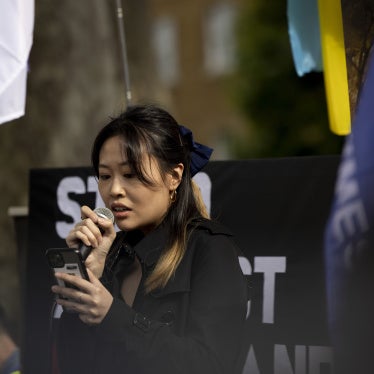(New York) – As many as several hundred Tibetans from eastern areas of the Tibetan plateau who live in Lhasa, the capital of the Tibet Autonomous Region (TAR), have been arbitrarily expelled from the city as part of a drastic security drive, Human Rights Watch said today. The policy measure appears to have been taken in response to an incident on May 27, 2012,in which two Tibetan protesters from eastern Tibet set themselves on fire in front of Lhasa’s famous Jokhangtemple.
Since the Jokhang incident, security forces in Lhasa have been carrying out sharply increased identity checks on the streets of the city. Tibetans from areas where protests have recently taken place, in eastern Tibet, have been ordered to leave not only the capital, but the TAR as well. Those expelled are not known to have been accused of any wrongdoing and there are no reports to date of non-Tibetans being expelled.
“This arbitrary expulsion of people because of their ethnicity or place of birth is clearly discriminatory and violates their basic rights to freedom of movement and residence,” said Sophie Richardson, China Director at Human Rights Watch. “Lhasa authorities should explain these extreme measures and be aware that additional arbitrary restrictions are likely to deepen tensions.”
Reports via social media and eyewitness reports shared with Human Rights Watch now indicate that Chinese authorities have imposed a range of limitations on movement in andaround Lhasa,including the expulsions, as well as a ban on public gatherings of more than three people in the city. This has ledto the cancellation of daily group activities,such as physical exercises normally held in front of the Potala Palace in Lhasa, according to a source in Tibet with direct knowledge of the events.
Human Rights Watch said these expulsions are unprecedented because they extend toTibetans who have valid business permits to live and work in Lhasa and who have been running businesses there for years. Other post-2008 expulsion campaigns around sensitive dates have focused only on those without permits to stay in Lhasa. Those currently targeted include Tibetans with valid temporary residence permits (zanzhuzheng in Chinese; gnas sdod lag khyer in Tibetan) to stay in the city.
Those expelled have not been not accused of any wrongdoing, are not believed to have any record of previous political activity, and do not have any known connection to the protestors involved in the recent immolations apart from being born in eastern Tibet.
On May 30, 2012, Hao Peng, a deputy Party secretary in the TAR, instructed all officials in the region that because “the Dalai clique’s sabotage activity has never ceased” they must “especially strengthen the control of key areas, [and] strengthen the service management of key personnel including the floating population,” a term sometimes used to refer to temporary residents and migrants from other provinces or areas of the Tibetan plateau.
The drive to push people out of Lhasa has been applied in particular to Tibetans from areas where there has been recent unrest, notably Aba (Ngaba in Tibetan) in Sichuan province, where at least 26 people have set themselves on fire in protest against Chinese rule since March2011, and Labrang, a Tibetan area in Gansu province which was the birthplace of one of the Tibetanswho self-immolated in Lhasa on May 27, 2012. Some reports suggest that Tibetans from Yunnan province, where there have been no political protests, are not among those being expelled from Lhasa.
In June 2012, asource in Lhasa told Human Rights Watch, “After the two Amdowans [Tibetans from the north-eastern Tibetan area] self-immolated in Lhasa in May, Lhasa started to expel all Amdowans. It didn't matter if these Amdowans had lived in Lhasa for years or were doing business there, none of them could remain in Lhasa, aside from those who had a letter of guarantee from the Public Security Bureau in their original domicile and one from their county government. Their homes are searched every day by police and many people have already been driven out.” Exile Tibetan organizations in India and US-based Tibetan-language radio stations have reported that several people in Lhasa associated with the two men who immolated themselves on May 27, 2012, have been detained.
Two more Tibetans, both from eastern Tibet, have immolated themselves since the May 27 protest in Lhasa. One was a woman in her mid-thirties from Rangtang (Dzamthang in Tibetan) county in Aba prefecture, Sichuan, who died on May 30, and the other was a man said to be in his fifties who died on June 12 in Jianzha (Chentsa in Tibetan) county in Huangnan (Malho in Tibetan) prefecture, Qinghai.
After large-scale unrest in Lhasa in March 2008, the TARauthorities have indicated that they view non-permanent residents of the capital as the biggest risk for social stability since they are less easily policed and monitored than permanent residents.
Lhasa authorities have imposed stringent security measures designed to prevent self-immolations, a symbolic act of defiance that undermines the government’s claim that Tibetans are grateful for Chinese policies in Tibet and that the situation is “stable.” People’s Armed Police (PAP) have been permanently stationed in the center of Lhasa, and on dates considered politically sensitive snipers are positioned on rooftops around the Jokhang temple. PAP officers frequently patrol carrying fire extinguishers, and all Tibetans arriving in the capital are subject to strict screening.
“Authorities in Beijing must understand that the solution to problems in Tibet does not involve more troops and discriminatory restrictions,” said Richardson. “It can only be found in respecting Tibetans’ rights.”
Background: Tibetans, immolations, and forcible removals
The eastern areas of the Tibetan plateau are administered as parts of Qinghai, Gansu, Sichuan,and Yunnan provinces in China, and are about 400 to 600 miles east of Lhasa. They are usually referred to in Tibetan as Kham and Amdo. All of the 39 self-immolations that have taken place were carried out by Tibetans from those areas. More than half of all Tibetans live outside the TAR, but many thousands live or work in Lhasa and large numbers travel there frequently on pilgrimage, since it is the religious and cultural centre of Tibetan Buddhism.
Sources in Lhasa describe their friends or relatives who have been forced by authorities to leave the TAR, including well-established businessmen with official permits. One source in Lhasa told Human Rights Watch that deportees “are given three to five days to pack and leave, after that they are taken by police car and forced to leave.”Other reports describe people being escorted by police to the train station or the airport to ensure their departure from the region and one source said that expulsions had led to “families being separated and businesses closed down.”It is not known if the expulsions are temporary or long-term.
Some reports say that the only eastern Tibetans who are permitted to remain in Lhasa are those with household registration (hukou in Chinese; them tho in Tibetan) in Lhasa, and those who can get a guarantee supporting their stay in the city from a higher-level government office or department. Until this month, a Tibetan visitor to Lhasa could obtain a business permit or temporary residence permit by getting a letter of support from a local street-level office known as a neighborhood committee plus, since 2006, a letter of confirmation from a street-level police office known as a jinqu.
One Tibetan who travelled by road from eastern Tibet to Lhasa reported on June 12 that he had been turned back by police at a checkpoint in Damshung, about 100 miles north of the city, and told that he could only be allowed into Lhasa “if a work unit above county-level issued [him]documents.”
Increasing Security
Since January 2012, the authorities in the TAR have taken increasing steps to prevent protests in Lhasa. On March 19, 2012, Xizang Ribao, a state media outlet, reported that Chinese President Hu Jintao had instructed leaders from the Tibetan areas to “regard maintenance of social stability as a heavy task and No.1 duty, firmly establish the thought that stability overrides all, strike in advance, fight the active battle, [and] strive to achieve the objective of no small incident, no medium incident and no big incident” in the Tibetan region. The authorities in Tibet issued orders that any official caught allowing an “incident” to take place would be immediately removed, and has announced the removal of at least 19 officials accused of failing to take strict measures in their areas.
TAR authorities announced that from March 1,2012, any ordinary citizen wishing to enter the TAR would need to show four different identity cards. The move was described as necessary in order to “further establish a comprehensive stability maintenance mechanism” and to control Lhasa’s “Eastern Gate,” according to state media.
Since early June 2012, Chinese bloggers who have posted more than a dozen photographs on the microblog website, Weibo, showing military vehicles in or on the outskirts of Lhasa, including tanks, mobile artillery, armored personnel carriers, and other heavy weaponry, sometimes in convoys of 20 of more similar vehicles.
Some ethnic Chinese tourists or residents in Lhasa have posted reports on Weibo of new security procedures affecting anyone entering the Barkor, the heart of the Tibetan quarter of Lhasa. A blogger in Lhasa wrote on June 12: “Went to the Jokhang today, and passing security the Tibetans had to register while the Han could go straight through. Just as I was about to pass through, I was pulled out by a PAP who wanted me to register! I said I'm Han, but he didn’t believe me and had to check my ID– I cried.”
A blogger called @hiroBuYaoAi wrote on June 12 that “Police patrols in Lhasa have been severe recently, people being detained in the streets, and every day people are being sent out on the train, of course most of them are Tibetans from the various prefectures and Tibetans from Sichuan and Qinghai.”Tsering Woeser, a prominent Tibetan writer and blogger based in Beijing, wrote on the same day: “Tibetans having their documents checked by Special Police in the streets of Lhasa. Some Tibetans say that if you don’t bring your documents, you can't go back.”
Other micro-blog reports give first-hand accounts of increased security measures in eastern Tibetan towns including Lithang and Yajiang in Sichuanprovince, and Markham in the TAR. The measures describe police or paramilitary checking all people entering and leaving the towns or areas, propaganda slogans pasted on walls by the paramilitary forces, patrols by troops with assault weapons, anti-riot police, and armed sentries outside government buildings.







